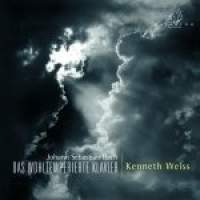Texte paru dans: / Appeared in: |
|
|
|
|
|
Reviewer: Bertil
van Boer
Bach’s two volume Das wohltempierte Klavier is about as iconic a work as one might find in the Western keyboard literature, and currently virtually any harpsichordist worth his or her salt has a go at them, either as a group or dividing up the pairs of 48 works into various volumes. Virtually one disc each year appears, and I have seen that this year, 2014, will have at least two complete versions, with Deutsche Grammophon set to release a rendition by Pierre-Laurent Aimard. The question of whether there is a market for the two dozen or so Here Kenneth Weiss performs the entire two sets of 48 preludes and fugues on a 1646 Ruckers harpsichord that underwent some revamping by Pascal Taskin in 1780. It therefore bridges the timespan and one must focus more on the sound of the pieces on this instrument than the works themselves. The
sound is quite delicate. This is no rhinoceros of an instrument, and the
sound tends to reflect the softer nature with which Taskin endowed it during
its restoration. Of course, it has been worked on since the 1780 and in 1972
the original mechanism was restored, which insures that we are hearing a
lightness of tone and exquisite responsiveness. Weiss’s playing is also
quite restrained, allowing the nuances of the music to emerge rather than
trying to “interpret” them. Even so, the Dies irae paraphrase in the opening
theme of the Fugue in C♯ Minor, for example, does lend itself to some
cautious structuring of the phrases. As a result we have an often flowing,
yet sedate recording that clearly speaks the music Bach wrote, rather than
trying to serve as a plate upon which the performer heaps his own ideas. It
may well be that there are a few who do not have the entire two volumes in
their collection, but if you are one, then this might be a consideration, in
that it gives a clear example of Bach’s purpose in writing such a plethora
of keys and how a harpsichord can best express itself in each. Bertil van
Boerrecordings that can be found today is a moot one, for they are
constructed in such a way that each new performance has the opportunity to
bring out hidden aspects. | |
|
|
|
|
|
|
|
Cliquez l'un ou l'autre
bouton pour découvrir bien d'autres critiques de CD |
|




